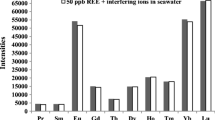Abstract
The aim of this study is to compare different resins regarding their separation and pre-concentration efficiency for uranium from aqueous solutions and its subsequent radiometric determination by liquid scintillation counting (LSC). The different types of the investigated resins include: (a) a pure cation-exchange resin (Dowex Marathon C), (b) a complex forming resin (Chelex 100) and (c) an impregnated resin (5% diethylene glycol succinate on Chromosorb W-H). The radiometric measurements were performed after mixing of the pre-concentrated aqueous phase with the liquid scintillation cocktail. The effect of experimental conditions such as pH, salinity (e.g. [NaCl]) and the presence of other chemical species (e.g. Ca2+ and Fe3+ ions or humic acid and silica colloids) on the separation recovery have been investigated at constant uranium/radioactivity concentration. According to the experimental results the maximum chemical recovery differs significantly from one resin to another as a function of either, pH or the other chemical parameters. The optimum pH is found to be 8, 4 and 8 for Marathon C, Chelex-100 and diethylene glycol succinate, respectively. On the other hand, generally Ca2+ and Fe3+ ions as well as the presence of colloidal species in solution (even at low concentrations) result in a significant decrease of the chemical recovery of uranium, particularly for Marathon C and the diethylene glycol succinate impregnated resins. Generally, among the studied resins Chelex 100 was superior regarding chemical recovery, selectivity, regeneration and reuse.







Similar content being viewed by others
References
Gómez EV, Tome FV, Lozano JC, Sanchez AM (1998) Extractive procedure for uranium determination in water samples by liquid scintillation counting. Appl Radiat Isot 49:875–883
Happel S, Letessier P, Ensinger W, Eikenberg JH, Thakkar AH, Horwitz EP (2004) Gross alpha determination in drinking water using a highly specific resin and LSC. Appl Radiat Isot 61:339–344
Vaninbroukx R, Stanef I (1973) Present status in the field of precision liquid scintillation counting. Nucl Instrum Methods 112:111–116
Zikovsky L (2002) Determination of alpha radioactivity in ground water by precipitation of alpha emitters with sulphates and hydroxides. J Radioanal Nucl Chem 251:329–331
Antoniou S, Costa C, Pashalidis I (2006) Alpha radiometry of seawater by liquid scintillation counting. J Radioanal Nucl Chem 270:593–596
Antoniou S, Tsiaili A, Pashalidis I (2008) Alpha radiometry of uranium in surface and ground waters by liquid scintillation counting after separation of the radionuclide by cation exchange. Radiat Meas 43:1294–1298
Prasada Rao T, Metilda P, Gladis JM (2006) Preconcentration techniques for uranium(VI) and thorium(IV) prior to analytical determination—an overview. Talanta 68:1047–1064
Vajda N, Kim C-K (2010) Determination of Pu isotopes by alpha spectrometry: a review of analytical methodology. J Radioanal Nucl Chem 283:203–223
Kiliari T, Pashalidis I (2010) Simplified alpha-spectroscopic analysis of uranium in natural waters after its separation by cation-exchange. Radiat Meas 45:966–968
Pashalidis I, Tsertos H (2004) Radiometric determination of uranium in natural waters after enrichment and separation by cation-exchange and extraction techniques. J Radioanal Nucl Chem 260:439–442
Guillaumont R, Fanghänel Th, Fuger J, Grenthe I, Neck V, Palmer DA, Rand MH (2003) Update of the chemical thermodynamics of uranium, neptunium, plutonium, americium, and technetium. Elsevier, OECD-NEA, Paris, pp 120–130
Skoog DA, West DM, Holler FJ (1994) Analytical chemistry—an introduction, 6th edn. Sounders College Publishing, Philadelphia, PA
Lehto J, Paajanen A, Harjula R, Leinonen H (1994) Hydrolysis and H+/Na+ exchange by Chelex 100 chelating resin. React Polym 23:135–140
Atzei D, Ferri T, Sadun C, Sangiorgio P, Caminiti R (2001) Structural characterization of complexes between iminodiacetate blocked on styrene-divinylbenzene matrix (Chelex 100 Resin) and Fe(III), Cr(III), and Zn(II) in solid phase by energy-dispersive X-ray diffraction. J Am Chem Soc 123:2552–2558
Hafez MB, Abo El-Khair BM (1983) Separation of some radionuclides from fission elements by adsorption on diethylene glycol succinate. J Radioanal Nucl Chem 78:25–28
Hafez MB, Nazmy AF, Eldesoky MM (1977) Fixation of radioactive elements on diethylene-glycol-succinate and its use for the determination of gross radioactivity in urine. J Radioanal Nucl Chem 41:29–35
Soupioni M, Symeopoulos B, Athanasiou J, Giolis A, Koutsoukos P, Tsolis-Katagas P (1999) A preliminary study of mercury uptake by a Greek zeoliferous rock in “Natural microporous materials in environmental technology” ed by Misaelides P, Macasek F, Pinnavaia TJ, Colella C. NATO Sci Ser E 362:365–369
Missana T, García-Gutiérrez M, Fernńdez V (2003) Uranium(VI) sorption on colloidal magnetite under anoxic environment: experimental study and surface complexation modeling. Geochim Cosmochim Acta 67:2543–2550
Pashalidis I, Buckau G (2007) U(VI) mono-hydroxo humate complexation. J Radioanal Nucl Chem 273:315–322
Konstantinou M, Pashalidis I (2010) Competitive sorption of Cu(II), Eu(III) and U(VI) ions on dunite in aqueous solutions: a potentiometric study. Int J Environ Technol Manag 12:322–332
Degueldre C, Triay I, Kim JI, Vilks P, Laaksoharju M, Miekeley N (2000) Groundwater colloid properties: a global approach. Appl Geochem 15:1043–1051
Acknowledgments
The research leading to these results has received funding from the University of Cyprus.
Author information
Authors and Affiliations
Corresponding author
Rights and permissions
About this article
Cite this article
Kyriakou, M., Pashalidis, I. Application of different types of resins in the radiometric determination of uranium in waters. J Radioanal Nucl Chem 287, 773–778 (2011). https://doi.org/10.1007/s10967-010-0883-z
Received:
Published:
Issue Date:
DOI: https://doi.org/10.1007/s10967-010-0883-z




